Noosa River Caravan Park facts for kids
Quick facts for kids Noosa River Caravan Park |
|
|---|---|

Noosa River Caravan Park, 2007
|
|
| Location | Russell Street, Noosaville, Shire of Noosa, Queensland, Australia |
| Design period | 1919 - 1930s (interwar period) |
| Built | 1929- |
| Official name: Noosa River Caravan Park | |
| Type | state heritage (built) |
| Designated | 3 April 2009 |
| Reference no. | 602706 |
| Significant period | 1929- |
| Significant components | other - recreation/entertainment: component |
| Lua error in Module:Location_map at line 420: attempt to index field 'wikibase' (a nil value). | |
The Noosa River Caravan Park is a special holiday spot in Noosaville, Queensland, Australia. It's listed on the Queensland Heritage Register, which means it's an important historical place. People have been camping here since around 1929, and it officially became a caravan park in 1956. This park shows how holidays have changed over time, especially with the rise of cars and caravans. It's a popular place for families to enjoy the Noosa River.
Contents
A Look Back: How Holidays Changed
The Noosa River Caravan Park is found at a place called Munna Point, right by the Noosa River. It started as a place for camping and fun in 1956. Before that, the land was set aside for public use since 1884. People were already camping here by 1929.
Early Days: Before Caravan Parks
Long ago, this area was a special place for local Aboriginal people. They used Munna Point for camping and fishing. In the late 1800s, the North Coast of Queensland started becoming a holiday spot. But it was hard to get to. Places like Tewantin and Maroochydore grew as holiday destinations. People liked calm rivers or quiet beaches for swimming, boating, and fishing. Camping was popular, especially during the Christmas holidays.
Cars and Caravans Arrive
Before World War I, these holiday towns were small. Most visitors came from nearby areas. People traveled by train and then used local transport to reach the coast. Tewantin was the biggest town because it was a port for the timber industry.
After the 1920s, roads got much better. This made it easier for people to visit the coast. The Bruce Highway was improved, and new bridges opened in 1929. These bridges connected Tewantin to Noosaville and Munna Point. A local businessman, Jack Parkyn, saw the chance to create holiday homes and a store at Munna Point. He even provided rowing boats for his guests!
As more people owned cars, camping and caravanning became popular. Caravans offered a "home away from home" with comforts. They were a new way to holiday, different from simple tents or busy hotels.
The Caravan Boom
After World War II, caravans became even more popular. More people had cars and longer paid holidays. By 1948, there were thousands of caravans in Australia. Clubs like the Caravan Club of Australia helped people learn about caravanning.
The Royal Automobile Club of Queensland (RACQ) also helped. They pushed for better roads and more caravan parks. In the 1950s, they pointed out that Queensland needed better facilities. They even published a guide called Modern Caravan Parks to help towns create good parks.
The Sunshine Coast grew a lot in the 1950s. More people wanted beach holidays. A new coastal road, the David Low Way, opened in 1960. This road linked popular resorts like Caloundra, Maroochydore, and Noosa.
Noosa River Caravan Park's Growth
The land for Noosa River Caravan Park was officially set aside for caravans and camping in 1956. This was early in the caravan boom. Caravan sales grew quickly in Queensland.
In the 1950s, not many places had good facilities for caravans. People looked to other countries for ideas on how to design parks. Caravan parks often had a clear layout, like a grid, with landscaped areas. They usually had a main road nearby, a clear entrance, and a caretaker. They offered things like concrete slabs for vans, electricity, and shared bathrooms with hot showers.
Caravan parks kept improving their facilities. By the 1960s, many council camping grounds became "caravan parks." In 1966, the Munna Point park got a new bathroom block. By 1968, there were many caravan parks along the coast, showing how popular they had become.
By the 1970s, caravanning was a common holiday tradition. Many families returned to the same park year after year. Caravans were a very popular type of holiday accommodation in Australia. They also helped local businesses in tourist areas.
Today, the Sunshine Coast has grown a lot. While caravan parks are still popular, there's pressure to use their land for other buildings. But the Noosa River Caravan Park has stayed open, offering affordable riverside holidays. It's an important part of Queensland's history and a special place for many families.
What You'll Find at the Park
The Noosa River Caravan Park covers about 3 hectares (7.4 acres) of land right on the waterfront. It's a green and leafy place with grassy areas and trees. It sits between the Noosa River and Weyba Creek, offering great views of the river.
Park Features
The park has spots for both caravans and tents, with or without power. It also has sandy beaches along the river and a picnic area for day visitors.
- Facilities: You'll find a large open camp kitchen, a boat ramp to access the Noosa River, and two brick bathroom blocks.
- Office: The caretaker's home and office are near the entrance on Russell Street.
- Layout: The park has a main road running through it, with smaller roads branching off. Caravan sites are usually along these smaller roads and have a concrete slab for your van.
- Activities: There are areas for unpowered tents and a day picnic area with tables, BBQs, and a fish cleaning table.
- Accommodation: The park does not offer permanent stays or cabins. The longest you can stay is three months.
Why This Place is Special
The Noosa River Caravan Park was added to the Queensland Heritage Register in 2009. This means it's recognized as an important part of Queensland's history and culture.
Showing How History Changed
The park helps us understand how the Sunshine Coast developed as a holiday spot. It's been used for camping since the 1920s and shows how tourism grew in the area. It also shows how early governments set aside land for public camping by the water, which is rare today.
The Noosa River Caravan Park also shows how holiday accommodation changed over time. It started as a simple camping ground and then became a modern caravan park. It kept updating its facilities to meet new needs. This park is a key example of the "caravanning phenomenon" that happened when more Australians started owning cars after World War II.
A Great Example of a Caravan Park
The Noosa River Caravan Park is a great example of a camping and caravanning site. People have been coming here for holidays since the 1920s. It's right by the water, perfect for swimming, boating, and fishing. This shows the main features of early camping reserves.
It also shows what a waterside caravan park should be like. It's in a great spot by the water, easy to reach by car, and has a simple layout. It offers different types of places to stay and has facilities like bathrooms, BBQs, and picnic areas. The park has changed over time to meet what holidaymakers need, but it still offers affordable holidays.


